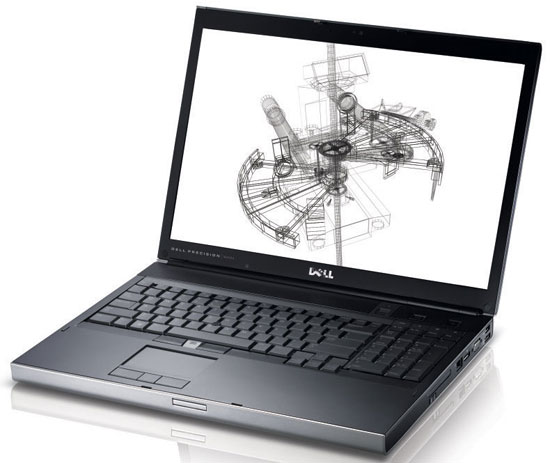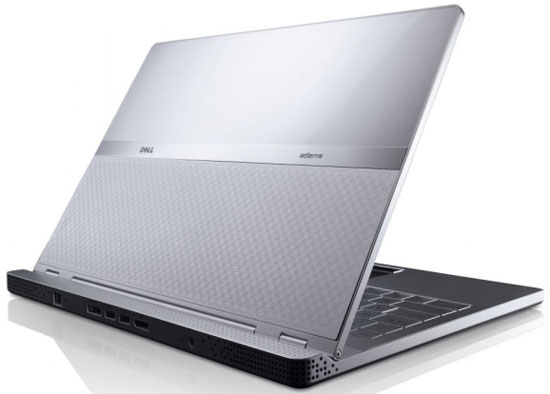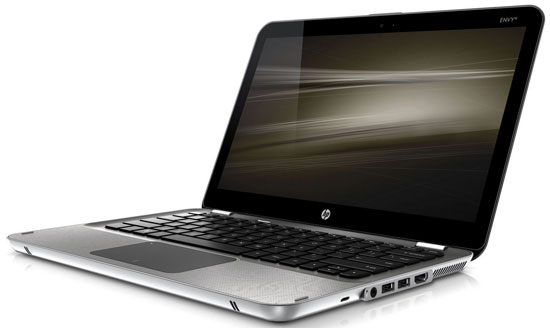Mobile Buyers' Guide, December 2009
by Jarred Walton on December 6, 2009 12:00 AM EST- Posted in
- Guides
Mobile Workstations
If you're looking for a truly powerful mobile workstation, there's really nothing else that can match the CPU power offered in the Clevo D900F. It will accept the fastest desktop Core i7 Bloomfield processors, giving you up to 3.33GHz of steady number crunching prowess. The D900F is a beast, weighing nearly 15 pounds and delivering an hour of battery life, but as a transportable workstation it will outperform any mobile CPU by a significant margin. Companies like Eurocom even support up to 24GB of memory if you need lots of RAM for a mobile server.

If you're looking for something less bulky, Dell's Precision M6400 is very nice and even has (or at least had?) a matte LCD option. The M6500 is the new Core i7 version of the M6400, with a higher base price. Both models have four SO-DIMM slots and support up to 16GB of RAM, or 8GB via four SO-DIMMs without breaking the bank. These notebooks are truly intended for workstation use, though, as they come with either NVIDIA Quadro or ATI FirePro GPUs, and they have a 3-year warranty standard.
Designer Laptops
If you're more interested in aesthetics than performance, look at the HP Envy and Dell Adamo laptops. We've already mentioned the HP Envy 15 as a gaming option, so we'll confine our discussions here to the Envy 13. Also note that the base model Adamo actually comes in at $1500, but any upgrades will bump you into the "high-end" territory.

At their core, Adamo laptops (including the XPS) are essentially CULV designs, but with an emphasis on being thin. The standard Adamo laptops ship with Core 2 SU9400 CPUs (1.4GHz, 3MB L2, 800FSB) - it's marginally faster than the Pentium SU4300 found in significantly less expensive laptops. Adamo battery life is listed as 5+ hours with a 40Wh battery. The Adamo XPS is a more exotic design with a fold-down keyboard, and it comes with a 128GB SSD and a 4GB DDR3 SO-DIMM with a starting price of $1800. The newer Adamo is available in black (onyx) or white (pearl), and it's available in two basic configurations. The $1500 "Admire" model has the same SU9400 and a 128GB SSD, but it ships with 2GB DDR3. The $2300 "Desire" ups the ante significantly, with 4GB DDR3, a 256GB SSD, and a Core 2 SL9600 CPU (2.13 GHz, 6M L2, 1066FSB). The SL9600 is a 17W TDP vs. 10W TDP for the SU9400, so battery life may also be slightly lower in that configuration.

The HP Envy 13 is similar in many ways, but with a bit more in the way of customization options as well as some higher performance accessories; specifically, HP includes a discrete ATI HD 4330 GPU on all Envy 13 models - good for graphics performance, but bad for battery life, but thankfully it's disabled and you use the IGP by default when unplugged. You can get the Envy 13 with SL9400, SL9600, or SU9600 CPUs (the latter two add $100 each, with the SU9600 actually providing the lowest performance but best power characteristics). Envy comes with 1GB DDR3 soldered on the motherboard and either 2GB or 4GB in the SO-DIMM slot. For the hard drive, HP lets users choose between a standard 250GB 5400RPM HDD, or you can upgrade to a 160GB SSD. That means unlike the Adamo, you're actually getting what we consider to be the best current SSD. HP also gives you a choice between a 13.1" 1366x768 LCD panel, or a 1600x900 panel for $100 more. Last, we'd look at adding the extra capacity 6-cell battery (which you can only get by purchasing the standard 4-cell with the 6-cell).
All told, the Envy 13 with the upgrades listed above will price out to $2475 ($2350 without the extra battery), and in terms of specs it looks to be better than the Dell Adamo. Having used neither one in person, we can't say which has the better feel, but there are numerous complaints about the Envy 13 touchpad and we recommend caution before taking the plunge. Honestly, while both laptops look nice, we'd still recommend saving a bundle of money and dropping down to something a little less stylish and a lot more affordable - any of the CULV laptops we mentioned earlier should suffice.










49 Comments
View All Comments
JarredWalton - Monday, December 7, 2009 - link
I've placed an order... I'll do a review if they work well.yacoub - Sunday, December 6, 2009 - link
http://i.i.com.com/cnwk.1d/i/bto/20091118/by-manf....">http://i.i.com.com/cnwk.1d/i/bto/20091118/by-manf....I can't find the initial article anymore but this just came out a couple weeks ago.
http://news.cnet.com/8301-17938_105-10400447-1.htm...">http://news.cnet.com/8301-17938_105-10400447-1.htm...
HP had the most quality issues, Asus the least.
Blahman - Sunday, December 6, 2009 - link
If you thought the UL80Vt was good, check out its newer slimmer brother: the UL30Vt. It shares all the same specs, but better build quality and all packed into a thinner, lighter chassis.It's available from Amazon for $800. The reviews so far are very positive.
http://www.amazon.com/UL30Vt-X1-13-3-Inch-Laptop-W...">http://www.amazon.com/UL30Vt-X1-13-3-In...ctronics...
trickdaddy111m - Tuesday, December 8, 2009 - link
The UL30Vt does look very nice, but it lacks discrete graphics and the Turbo function of the UL80Vt. So, "same specs" is not accurate.KikassAssassin - Wednesday, December 9, 2009 - link
The UL30Vt has turbo and the discrete graphics. The specs are exactly the same as the UL80Vt except it has a 1" smaller screen, no optical drive, and a slightly smaller battery.You're probably looking at the UL30A.
KikassAssassin - Sunday, December 6, 2009 - link
The UL30Vt looks like a really nice alternative if you want something lighter than the UL80Vt and you don't need an optical drive. Unfortunately, the UL30Vt on Amazon is the X1 model that only has a 4400 mAh battery, compared to the UL80Vt-A1's 5600 mAh battery, so it'll only have about 80% of the battery life. The battery life should still be excellent, just not quite as amazing as the UL80Vt'stechwriters4breakfast - Sunday, December 6, 2009 - link
atom 2arrandale
bsoft16384 - Sunday, December 6, 2009 - link
I just want to give another shout out for the Acer 1410. This is an absolutely fantastic notebook for $400.I have the single-core version (Core 2 Solo SU3500, 1.4GHz, 3M cache) so it's somewhat faster on single-threaded code but slower on multi-threaded code than the Celeron SU2300 (1.2GHz, 1M cache). That said, I have no performance complaints about the laptop.
GPU performance is, as you would expect, pretty bad. But it's still dramatically ahead of a GMA950-based netbook (around 5X by my estimations), which makes it fine for playing older titles like Warcraft III, CS 1.6, UT classic or 2004, Quake 3 / OpenArena, Half-Life.
Even WoW runs "OK" on the Acer 1410, as long as you're willing to deal with ~20-30 FPS and a slideshow in Dalaran. But you *can* run it, and it's fine for doing dailies or checking the AH. I have my desktop if I want to play for real.
The keyboard is excellent, except for the page up/down buttons (which are annoyingly above the arrow keys) and home/end (combined with page up / down). Other than those annoyances, the keyboard is full-sized and has the layout that you would expect.
The screen is decently bright; contrast is "OK" but not great, and the viewing angle is lame (but so are most laptops). It's easily better than my ThinkPad T61.
There are some surprises port-wise: the 1410 has HDMI (with 8-channel LPCM audio) and the audio-out port does SPDIF/TOSLINK (with a 3.5mm to TOSLINK adapter), neither of which are common on a $400 laptop.
The WiFi is Intel 5100 802.11n, which is also nice. Ethernet is Atheros, audio is Realtek.
As you would expect with an ULV notebook, the 1410 doesn't really ever get hot, even at 100% CPU / GPU. It's not particularly noisy either, unless you have a defective fan (as my first one from Amazon did).
The 1410 takes forever to charge from empty (2.5 hours if off, 3-4 if on). That's because it uses the same 30W power supply as the Aspire One. On the other hand, the power adapter is very small and decently cheap, both of which are pluses.
Battery life is 5-6 hours, depending on how hard you push the machine. At idle, at minimum brightness, Windows reports over 12 hours, but you can't achieve this in practice. With light web browsing and Flashblock, expect 6+ hours.
The touchpad is Synaptics, and does multi-touch.
This system is the smallest, lightest system that I would consider a 'notebook' rather than a 'netbook'. I considered the HP Mini 311, but it maxes out at 3GB and doesn't support x86-64 or virtualization, plus the Core 2 Solo beats the pants off of the Atom. NVIDIA ION isn't really a whole lot better than the GMA X4500MHD, because the Atom CPU prevents you from playing any modern games anyway and the GMA X4500 does fine for Windows Aero and HD video acceleration.
Two years ago the Aspire 1410 would have cost $2000 and would be called an 'ultralight'. Today it's $400.
Keeir - Wednesday, December 9, 2009 - link
Don't forget its slightly more expensive brotherTimeline 1810T-8
Core 2 Duo (SU7300), 4 Gigs of Ram, Bluetooth, Larger HD, same wieght and battery
Picked mine up for <600 from Amazon (though I see they have ballons to close to 700)
notanakin - Monday, December 7, 2009 - link
Unfortunately this guide came out just a few days too late, but fortunately I'd settled on the Acer 1410 (SU2300) and it's a nice little machine. Certainly fast enough for simple tasks and for my old eyes the screen size is better than the 10.1 inchers.Here's a very useful link to a table of laptops/CPUs/Screen size prepared for the recent PC Show in Singapore where I bought the laptop. Great for doing some quick comparisons.
(Prices are in Singapore $ - about US$1=S$1.4, so the prices are a bit more expensive than in the USA, but they give some discounts off the published price and throw in stuff - I got an external DVD-writer plus a few smaller things with the Acer.)
But how I HATE the glossy screen. Are they cheaper than matte screens or what? I'd gladly pay US$50 more for a matte screen.